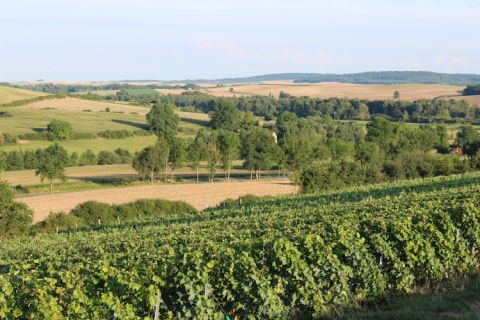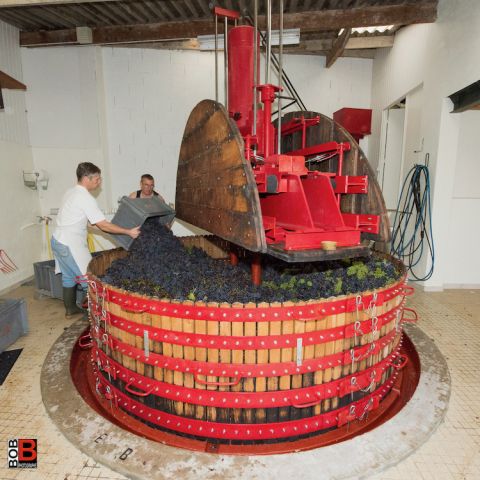My wine of the week, a delicious champagne from a small family grower, is dedicated to Dee, on this our wedding day.
From €32.50, HK$318, $45, 411.25 Swedish kronor, 1,048 Czech korunas, 44.62 Swiss francs, 349.50 Danish kroner, £47.50, AU$84; £255 per case of six
I am not the the only one celebrating today. Clémence and Cyril Jeaunaux-Robin (above) tell me they plan to start the 2022 harvest today in their vineyards in the little village of Talus St-Prix south of Épernay in the Coteaux du Petit Morin, between the Côtes des Blancs and the Côte de Sézanne (see this overview map of Champagne).
The name of this wine, Éclats de Meulière, tells you a lot about their land and the style of the wine.
Meulière is French for buhrstone (sometimes millstone), a type of flinty calcareous rock that is typically used for the millstones used in a traditional mill. Éclats has several meanings, including 'bursts' (as in bursts of light) or 'fragments', though in the singular in English it means 'style' or 'flamboyance' or 'sparkle', so it's a clever play on the fact that the organically certified Jeaunaux-Robin vineyards in the Vallée du Petit Morin are littered with fragments of flint (pictured below): both silex (formed under the sea) and meulière (formed in fresh water). They believe that this 'brings minerality, freshness and a light smoky taste' to their wines.
This was certainly true of the Éclats de Meulière Extra Brut, which I tasted in London with Clémence, alongside the even more minerally Éclats de Meulière Brut Zero. In the Extra Brut, which has a dosage of 3.5 g/l and tastes dry but not in the least austere, I found a perfect balance between aromas and flavours of orangey citrus and peachy, just-ripe apricot within a crisp framework of acidity, which holds everything in tension, as well as seemingly contradictory notes, none of them dominant, of yeasty bread, non-sweet wildflower honey – more apparent as the wine warms in the glass – and a stony/smoky character.
However, there are no contradictions in this wine, simply an elegant balance among all these elements: a wine that is not in the least flashy but is beautifully modulated, with fine mousse and a persistent finish and just 12% alcohol.
This pale-peachy-gold wine, organically certified by Ecocert, is a blend of 60% Pinot Meunier, 30% Pinot Noir and 10% Chardonnay, with about 70% of the wine coming from the 2019 vintage and the rest from 2018. They say they prefer not to use very old so-called reserve wines because they want to accentuate freshness. The vines, planted by Cyril's father Michel and grandfather Georges, are on average 50 years old. They have a programme of regular but gradual vine renewal to maintain a high average vine age (certainly high for the Champagne region). They farm 7.2 ha (c 18 acres), including one steeply sloping hectare in Montier en l'Isle in the more southerly Côte des Bars.
One-quarter of the base wine was fermented with indigenous yeast and aged in seasoned oak (barrels more than 10 years old), the rest in tank with yeast inoculation. Malolactic conversion is avoided, and the wine spent about 30 months on the lees before it was disgorged in September 2021. Vintages and disgorgement date are usefully engraved on the bottle though the writing is not that easy to read. The back label is a paragon of concise information on varieties, soils and winemaking basics.
Talus St-Prix is not the best-known of Champagne villages. It numbers just 100 inhabitants and 39 ha (96 acres) of vines but, unusually, the area is dominated by Pinot Meunier (70% compared with the average across the Champagne region of 30%). This is because the valley of the Petit Morin, a tributary of the Marne, brings freshness and humidity to the vines but also the risk of spring frosts. Pinot Meunier buds later than the other Champagne varieties and is therefore a safer bet. The south-facing Jeaunaux-Robin vineyards comprise 54% Pinot Meunier, 21% Pinot Noir, 24% Chardonnay and 1% Petit Meslier. The soils vary but are mostly hard limestone, shallow white marls plus the flint stones, both large and small, described above.
Cyril and Clémence are the third generation, having in 1999 joined Cyril's parents, who are retired but still help out every day. Grandfather Georges used to deliver his grapes to the co-op and the family brand was not created until 1976. Cyril and Clémence introduced several changes: they brought back tillage and grass cover in the vineyards and the use of neutral oak for fermentation of part of the blend; they bought the family's second traditional Coquard basket press (one is pictured below); and they also were the drivers behind the conversion to organics and the first exports. In 2009 they joined the Terre et Vins de Champagne producers' association. (See Tim Hall's summary of some of the better-known such groupings.) Of their three sons, Gautier, 20 (a design student), Amaury (18, about to begin studies in political science) and Anselme (15), it is the youngest who wants to be a winegrower. Though as in many small family businesses, all are involved in the winery or vineyard during harvest.
When Clémence told me that they planned to start harvesting on the auspicious 2 September, I asked her about the vintage. She thinks it's looking very good, after an early start in the spring and healthy vines thanks to a dry spring and 'beneficial rains' at the right time. 'Fortunately, the few heatwaves in the summer didn't impact the vines; only a few toasted leaves in places. After a complicated 2021, it is really good to see such beautiful grapes! We estimate the harvest in the high range of what we can expect from a harvest, around 11–12,000 kg/ha on average.'
They are about 15 days ahead compared with the average of the last 10 years. It's harder, she explains, to reach the holy trinity of 'the right level of sugar, enough acidity and above all a nice aromatic' in an early harvest. 'We quickly reach the level of sugar but the aromatic takes more time.'
The Extra Brut, along with several other Jeaunaux-Robin champagnes, is imported into the US by Valkyrie Selections and available from The Bottle List (Napa), Vintage 38 (Wisconsin Dells), The Wine Connection (San Diego), Apex Fine Wine (Cary, NC), Martin Wine & Spirits (New Orleans), Arcadia Premium (Phoenix), Wine Empire (Ashland, MA) and The Urban Grape (Boston).
UK importer GB Wine Shippers are offering a case of six for £255 (contact info@gbwineshippers.co.uk) and GB's Gus Gluck tells me the wine is available by the bottle from The Good Wine Shop, Vindinista, Shrine to the Vine (all London) and St Andrews Wine in Scotland, as well as being on an increasing number of restaurant lists. They export to 30 different markets so it's also widely available in Europe and Asia.
Click on this link to find many more stories about growers' champagnes on JancisRobinson.com.






